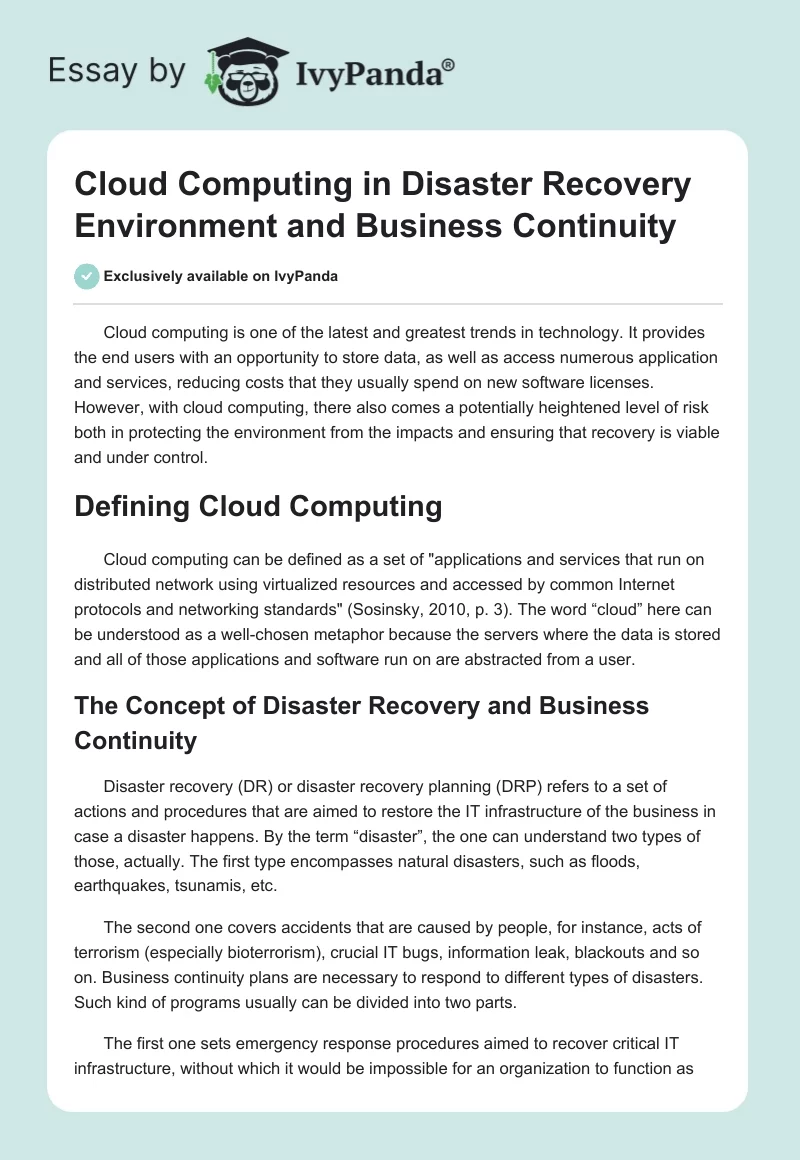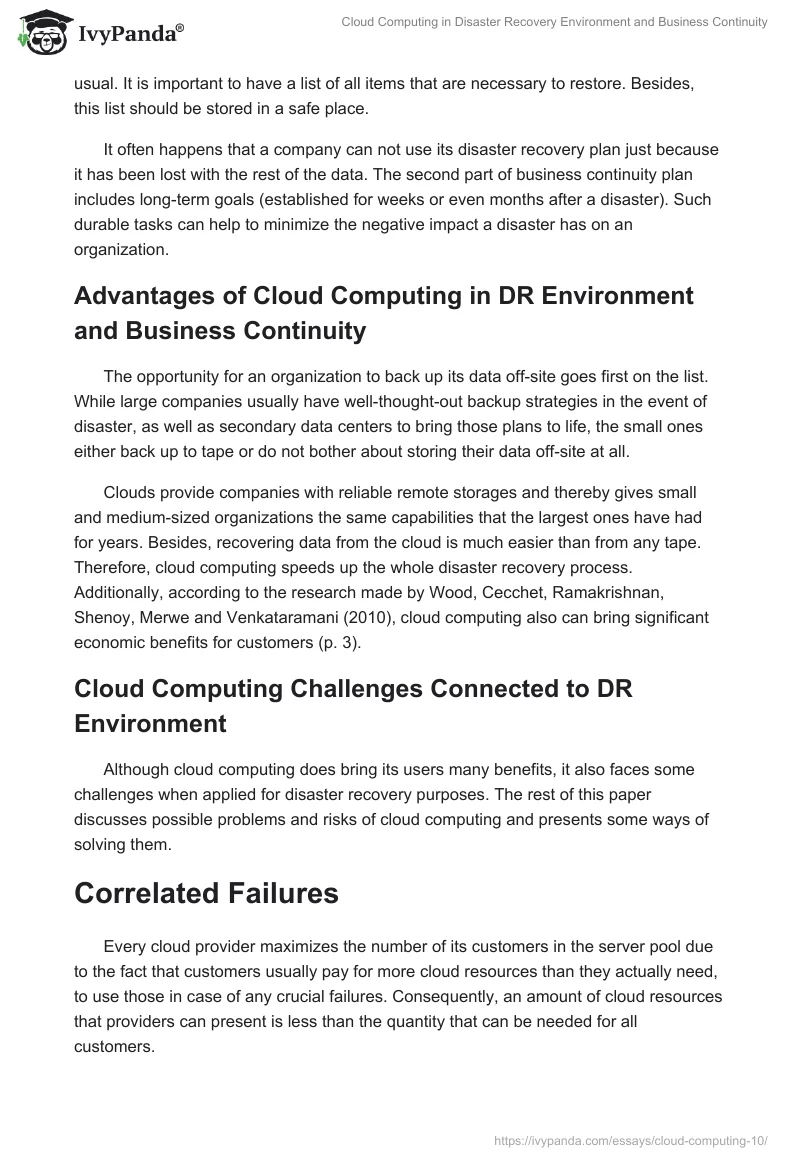Cloud computing is one of the latest and greatest trends in technology. It provides the end users with an opportunity to store data, as well as access numerous application and services, reducing costs that they usually spend on new software licenses. However, with cloud computing, there also comes a potentially heightened level of risk both in protecting the environment from the impacts and ensuring that recovery is viable and under control.
Defining Cloud Computing
Cloud computing can be defined as a set of “applications and services that run on distributed network using virtualized resources and accessed by common Internet protocols and networking standards” (Sosinsky, 2010, p. 3). The word “cloud” here can be understood as a well-chosen metaphor because the servers where the data is stored and all of those applications and software run on are abstracted from a user.
The Concept of Disaster Recovery and Business Continuity
Disaster recovery (DR) or disaster recovery planning (DRP) refers to a set of actions and procedures that are aimed to restore the IT infrastructure of the business in case a disaster happens. By the term “disaster”, the one can understand two types of those, actually. The first type encompasses natural disasters, such as floods, earthquakes, tsunamis, etc.
The second one covers accidents that are caused by people, for instance, acts of terrorism (especially bioterrorism), crucial IT bugs, information leak, blackouts and so on. Business continuity plans are necessary to respond to different types of disasters. Such kind of programs usually can be divided into two parts.
The first one sets emergency response procedures aimed to recover critical IT infrastructure, without which it would be impossible for an organization to function as usual. It is important to have a list of all items that are necessary to restore. Besides, this list should be stored in a safe place.
It often happens that a company can not use its disaster recovery plan just because it has been lost with the rest of the data. The second part of business continuity plan includes long-term goals (established for weeks or even months after a disaster). Such durable tasks can help to minimize the negative impact a disaster has on an organization.
Advantages of Cloud Computing in DR Environment and Business Continuity
The opportunity for an organization to back up its data off-site goes first on the list. While large companies usually have well-thought-out backup strategies in the event of disaster, as well as secondary data centers to bring those plans to life, the small ones either back up to tape or do not bother about storing their data off-site at all.
Clouds provide companies with reliable remote storages and thereby gives small and medium-sized organizations the same capabilities that the largest ones have had for years. Besides, recovering data from the cloud is much easier than from any tape. Therefore, cloud computing speeds up the whole disaster recovery process. Additionally, according to the research made by Wood, Cecchet, Ramakrishnan, Shenoy, Merwe and Venkataramani (2010), cloud computing also can bring significant economic benefits for customers (p. 3).
Cloud Computing Challenges Connected to DR Environment
Although cloud computing does bring its users many benefits, it also faces some challenges when applied for disaster recovery purposes. The rest of this paper discusses possible problems and risks of cloud computing and presents some ways of solving them.
Correlated Failures
Every cloud provider maximizes the number of its customers in the server pool due to the fact that customers usually pay for more cloud resources than they actually need, to use those in case of any crucial failures. Consequently, an amount of cloud resources that providers can present is less than the quantity that can be needed for all customers.
Such kind of strategy usually works because all clients can hardly experience any crucial failures at the same time. However, those circumstances are not so improbable: “for instance, an electric grid failure or a natural disaster such as a flood can cause a large number of customer from a geographic area to simultaneously failover” (Wood et al., 2010, p. 6).
In order to solve this problem, customers from the same geographic area should be connected to various data centers of the cloud. Still, it is only one way of correlated failures to happen, and there are even more of them. They can only be prevented if all data centers of the same cloud provider would be perceived as a single unit, which contain resources that should be available to the customers any time they need them. Nevertheless, just for now, data centers still exist as separate units, and this problem has to be solved in the future.
Insufficient Revenue
The second important challenge of DR cloud computing is insufficient revenue. This one can be explained in the following way. According to various disaster recovery strategies, the majority of DR resources are to be paid by customers only in case if they have experienced any failures. However, the cloud provider has to keep those resources available all the time, even if there is no any disaster.
Hence, it is not surprising that such kind of DR resources does not bring much revenue. To make the investments valuable and maximize revenue, a DR provider can start providing non-DR services, in other words, “rent” its DR resources to the usual cloud computing users. Surely, all of these should be done carefully in order to avoid “double book” (Wood et al., 2010, p. 6).
Security and Privacy
Finally, the last in this list (but not the least in importance) is the problem of security. This problem is rather disturbing since it can not be solved once and for all. Since the customer’s data is stored in the cloud, i.e. on the Internet, there is always a possibility that even the most reliable and safe security systems can be broken by the hackers.
So, there is not any evident and final solution. However, some precautions still can be taken. Among those, for example, is the two-step verification, when after an authorization a customer is asked to enter a particular code that has been sent to him by SMS. The owners of companies that provide cloud computing services claim that “they live and die by their reputations” and do their best to provide the best security they can (Jadeja & Modi, 2012, p. 880).
To conclude, although the opportunities provided by cloud computing indeed are priceless, there are still many challenges to get through. Among those are correlated failures in case of a disaster, insufficient revenue in connection with idle DR resources and the security issue, which is the most disturbing one.
References
Jadeja, Y., & Modi, K. (2012). Cloud Computing – Concepts, Architecture and Challenges. Web.
Sosinsky, B. (2010). Cloud Computing Bible. Hoboken, NJ: John Wiley & Sons.
Wood, T., Cecchet, E., Ramakrishnan, K. K., Shenoy, P., Merwe, J., & Venkataramani, A. (2010). Disaster Recovery as a Cloud Service: Economic Benefits & Deployment Challenges. Web.


